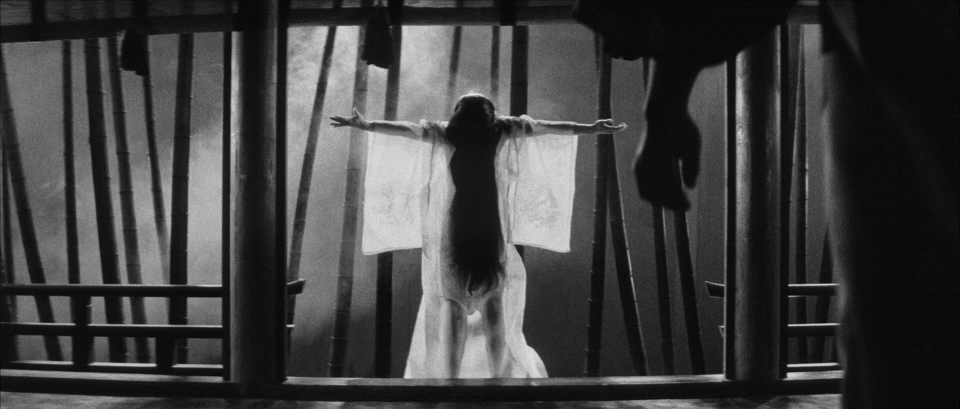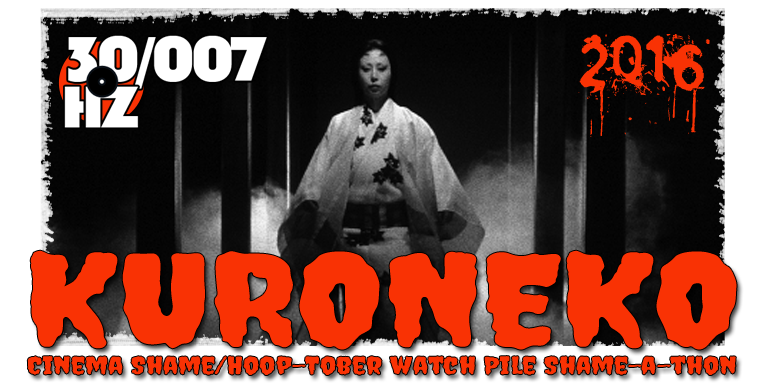
31+ Days of Horror. 33 Horror Movies. 33 Reviews. Hooptober Challenges and Bonus Tasks.
View my 2016 Cinema Shame/Hoop-Tober Watch Pile Shame-a-thon Statement here.
Nature of Shame:
Unseen Criterion Shame
Hoop-tober Challenge Checklist:
Decade – 1960’s
Country of Origin – Japan
#18. Kuroneko (1968)
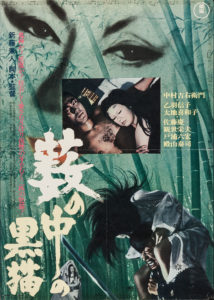
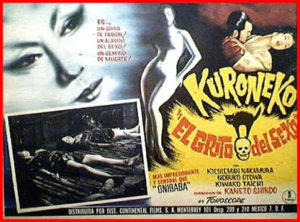
Yabu no Naka no Kuroneko, the Japanese title for Kuroneko takes the prize for most literal name of a transcendent piece of cinema. (I assume.) The literal English translation, “A Black Cat in a Bamboo Grove,” paints a very precise picture. Kaneto Shindo’s film showcases bamboo groves and black cats, oftentimes in the same image and beautifully rendered. Truth in advertisement.
Of course, such precision fails to convey nuance beyond the light and shadow. Even without nuance, however, Kuroneko is a beautiful film. A collection of still images could populate an entire gallery installation.
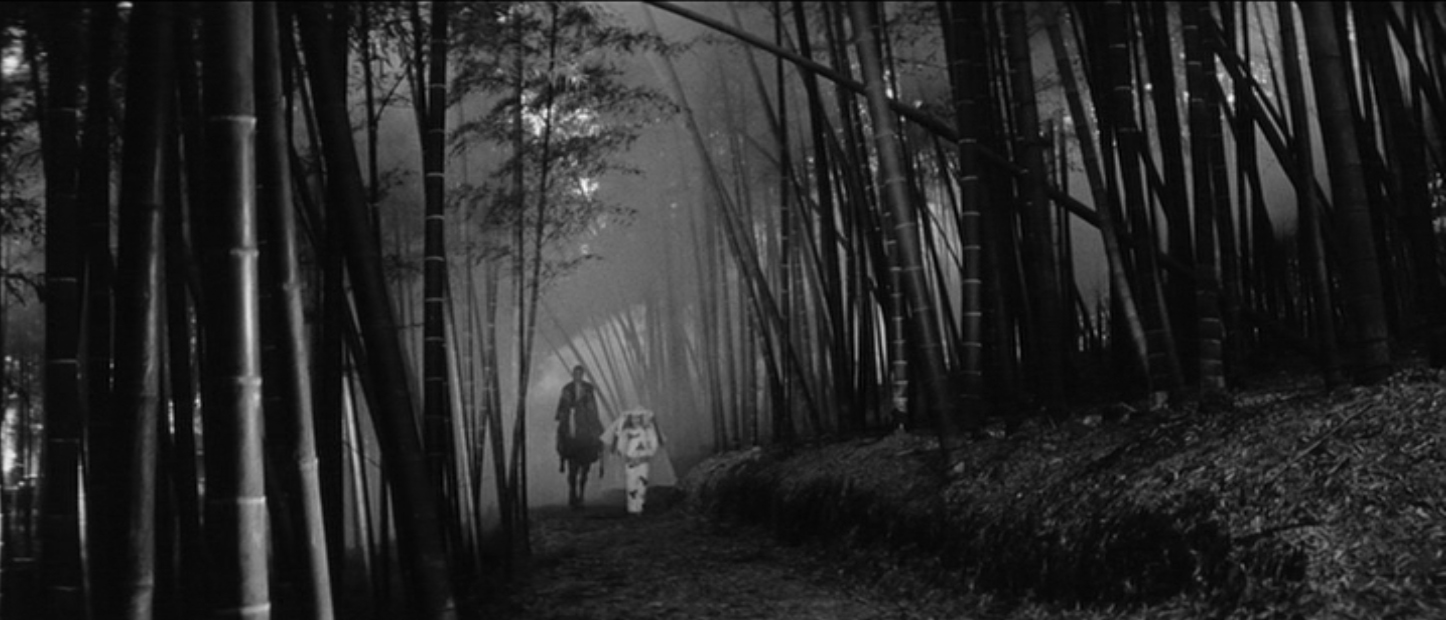
A band of traveling samurai rape and murder Yone and her daughter-in-law Shige. They burn down their house, take their food and depart. A black cat appears and licks the bodies of the women. The women return as spirits having pledged to avenge their death by murdering all samurai. All samurai includes Shige’s husband Gintoki who’d gone off to war in the faraway north. They lure their samurai to an illusory estate in a bamboo grove (a spot near where their house once stood), seduce, then destroy. When news of these samurai butchers reaches governor Raiko, he sends Gintoki to destroy the spirits.
The term “elegiac” resonated while watching Kuroneko. The word itself rolls off the tongue and inspires non-specific romantic pining, sort of like Hector Elizondo. Literally “elegiac” means an expression of sorrow for something now past.

The women react to the lives they’ve lost, the blissful illusion of sanctuary. A home, a family, the belief in the altruism of a protective warrior class. As farming peasants, as women, Yone and Shige represented the lowest tier of the caste system, other than ethnic minorities, convicted criminals, etc. (the “burakumin”). Despite their status, they lived a contented existence. A violent death and total disillusionment ferried them back to their vengeful purgatory where they are charged with more than just measure-for-measure revenge. Within this context of mourning the loss of their life and a worldview of untarnished pastoral purity, the notion of Kuroneko as an elegy becomes especially potent.
Let’s further consider the definition of elegiac within poetry. I had to brush up on the broader strokes of the elegiac couplet because it’s been almost twenty years since I last used or studied the term. Greek lyrical poets used elegiac couplets for themes on a smaller scale than the epic. The couplet stands on its own but contributes to the larger work. Individual, isolated pieces of the whole. Though for this conversation the specifics don’t necessarily matter as much as the function of the elegiac couplet. Let’s dig up some of that Freshman English class.
From wikipedia:
Each couplet consists of a hexameter verse followed by a pentameter verse. The following is a graphic representation of its scansion. Note that – is a long syllable, u a short syllable, and U is either one long syllable or two short syllables:
-
-
-
– U | – U | – U | – U | – u u | – –
-
– U | – U | – || – u u | – u u | –
-
-
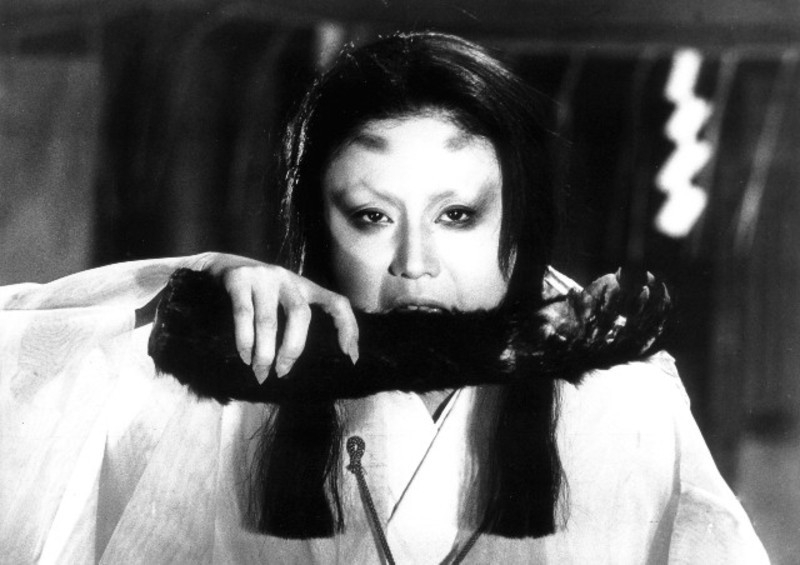
In it’s original Greek and eventually Latin usage, the elegiac couplet was considered a lesser art form. Elegiac poets liberally borrowed the themes of the epic in order to lend more gravitas to the shorter, more accessible elegies. As a horror film, also typically considered lesser art, does not Kuroneko struggle against the same kind of bias? The themes of Kuroneko resonate well beyond the horror genre.
The beauty of the couplet manifests in poetic simplicity. The same holds true for Kuroneko narrative, which relies on light, shadow and often silence. Fog dances among the bamboo forest, the reeds of which appear overdeveloped during processing and reinforces the haunting estate’s isolation. Pure whites and pure blacks. Only the fog lies somewhere in between. Nothing but blackness appears beyond the forest. This turns the most minimal of set designs into limitless space.
Though Shindo handles the seduction of the samurai with a deft touch, and an eye first concerned with visual poetry, Kuroneko embraces the thematic essentials of a horror film. He begins the film with the massacre of the women and their home, but shows none of the samurai’s overt trespasses. The violence agains the women is left to the imagination — only an image of their charred bodies — but our imagination is often more potent. The women, however, exact their pound of flesh by biting their victims in the neck, ripping throats like a big cat killing its prey.
When Gintoki arrives at the women’s lair, the film strays from any horrific imagery and moves toward a Shakespearean tragedy. Two lovers, reunited. An unnatural coupling of man and spirit. Shige surrenders her soul to hell for one more week with her husband. Meanwhile Gintoki’s mother, bound by her oath to destroy the samurai, offers her son no family discount.
Whether you’re spellbound by the imagery or wrapped up in the sworn vengeance of the wronged women, Kuroneko casts a timeless spell. Conservation of language. The visual poetry of the black and white image. Revenge and honor. Love and death. The shattered sanctuary of home. Elegiac, indeed.
Final Thoughts:
After finishing Kuroneko, I sat in silence, watching the Criterion menu. The ultimate sign of respect for any film — silent reflection. (Though, on the flipside, I also sat silently after finishing Nightmare on Elm Street 2 because holy hell that was one terrible movie.)
30Hz Movie Rating:

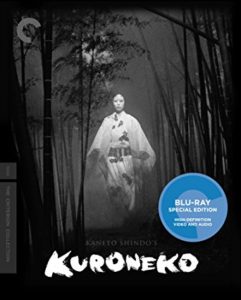 Availability: The Kuroneko Criterion Collection Blu-ray/DVD can be purchased wherever fine Criterions are sold.
Availability: The Kuroneko Criterion Collection Blu-ray/DVD can be purchased wherever fine Criterions are sold.
Earlier 2016 31 Days of Horror entries: #1. Vampyros Lesbos / #2. A Chinese Ghost Story / #3. The Haunting of Morella / #4. Delirium (1972) / #5. A Lizard in a Woman’s Skin / #6. She-Wolf of London / #7. Son of Frankenstein / #8. Killerfish / #9. The Bride of Re-Animator / #10. A Bay of Blood / #11. The Seventh Victim / #12. The Fly (1958) / #13. The Fly (1986) / #14. Deep Red / #15. Dracula’s Daughter / #16. Day of the Animals / #17. The Unknown

